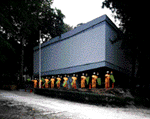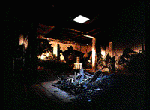




 Inside the Japanese Pavilion.
Inside the Japanese Pavilion.
The entire walls are covered by photos
that were taken in the disaster stricken areas of
Kobe by MIYAMOTO Ryuji.
The photos were printed on roll paper and
spread around at the site.
The height of the wall is approximately 5 meters
and the total length is 100 meters.
Phot=MIYAMOTO Ryuji
During the two months from September 15 to November 17 the Sixth International Architecture Exhibition, Venice Biennial was held in Venice. This celebration of modern art and architecture in Venice, a city known for its festival lovers, has come to be regarded as a regular event in Europe. This time, at the Architecture Biennial, the architect, Hans HOLLEIN, served as General Director and was supported by five international experts, including ISOZAKI Arata.
The site, located in a beautiful park surrounded by water, consisted of two main sections: a central pavilion that housed all the works of architects who had been selected from around the world and 28 other pavilions from the 32 participating countries.
In the central pavilion, under the theme of "Sensing the Future, the Architect as Seismograph," the works of 39 well-known groups of architects who are the leaders of contemporary architecture were exhibited. Japan was represented by the works of ANDO Tadao, ISOZAKI Arata and ITO Toyoo. In addition, under the theme of "Emerging Voices," works were shown from 32 groups of young architects, including HASEGAWA Itsuko, IRIE Kei'ichi, KISHI Kazuo and SEJIMA Kazyuo (According to HOLLEIN, these are people who haven't received worldwide recognition yet but who are leading the way with their new approaches).
"Contemporary architects can be considered as cultural seismographs," says HOLLEIN. Currently, new philosophies, trends and views towards the future that involve architecture are no longer developed from common dogma, truth or movements based on guidelines, but rather they develop from the point of view or work of architects as individuals. To put it another way, HOLLEIN believes that, as in the other arts, architects are personalizing their work and acting as seismographs, accurately and sensitively sensing conditions (that the individual architect has placed themselves in) that are continuously changing along a variety of vectors and which are reflected in their work.
Indeed, a lot of people who are involved in architecture are feeling that current architectural designs are in a chaotic condition worldwide. In fact, although each of the much talked about current works that are on display in the central pavilion (you probably are already familiar with them if you regularly read architectural magazines) are very interesting, none of them offer a design or philosophy that has the potential to provide direction. So it can be said that the theme, "Architects as Seismographs" might have been the result of HOLLEIN's determined attempt to comprehend these ambiguous conditions.
In a beautiful woods, each country's pavilion stands quietly (more precisely, slightly awkwardly). Of these different pavilions, one has a strong impact on the people who attend the biennial. It is the Japanese pavilion for which ISOZAKI Arata is the commissioner.
The theme of the Japanese pavilion is "Fractures." It goes without saying that it relates to the great earthquake that struck the Hanshin region in the early morning of January 17, 1995.
ISOZAKI states in the pamphlet for the Japanese Pavilion, "As the commissioner of the Japanese pavilion, I believed that it was better to portray accurately the state of contemporary Japanese architecture in this violently wrecked ruin of the city rather than through some optimistic architectural proposal." The Japanese Pavilion, successfully transmits a message that thoroughly satisfies the visitor (The Japanese Pavilion received the Venice Biennial Golden Lion Award, which is given to the best pavilion).
The visitor's first view is a scene in which "working robots" wearing yellow work jackets, which seem out of place in beautiful Venice, are restlessly waving flags in front of a plain concrete building. In particular, because it is facing diagonally from the simple but sophisticated Denmark pavilion, it has a strong kitsch effect. However, because this scene is so typically Japanese, I couldn't help but make a wry smile.
But, once I stepped into the building, I can honestly say that I literally was left speechless. It might have been because I was virtually experiencing there in Venice, which itself seemed like a beautiful ruins, that great earthquake, which had struck at peaceful and ordinary everyday Japanese, a year and half after the fact. Or it might have been because I was born in Kobe, which was deeply wounded by the earthquake and grew up in Ashiya where there were a lot of casualties.
The floor of the building was covered from wall to wall in rubble that was actually brought from Kobe (mainly architectural materials from destroyed houses). One of the participating artists, an architect MIYAMOTO Yoshiaki actually lived through this earthquake, and had his own "house" destroyed. After the earthquake, he made an attempt to convert the relationship between the residents and "houses" from a utilitarian level to the level of memory, by piling up rubble in the center of the city. At the installation in Venice, this attempt transcended the framework of Kobe, and became something that gives a new understanding to the uncertainty of that most essential activity in architecture, "construction."
![]()
The monochrome photographs of the horribly devastated buildings of the city, which covered the walls, were the work of MIYAMOTO Ryuji. MIYAMOTO is known as a photographer who takes photos of buildings that are abandoned and lying in ruins in modern settings. These photos that were taken in Kobe right after the earthquake are indeed of modern ruins. From these photos, the depth of the wound that modern architecture received can be directly perceived.
In addition, a computer installation placed on the rubble by the architect ISHIYAMA Osamu sharply criticizes the development and vulnerability, which are two sides of the same coin, of a very highly technological modern city. The computer produces random and tense sounds from a TV (or radio) broadcast of a report of the damage right after the earthquake. These sounds produced for me a momentary confusion at the border between truth and falsity.
I don't know if people from different countries and regions who visited the Venice Biennial would agree with my impression. I assume that perhaps for a lot of non-Japanese it is a shocking concept that the ruins of the city due to a natural disaster can more accurately express the architectural state of a country than the works of a famous architect and that it gives a greater sense of the reality than the actual information that a big earthquake occurred in a region in Japan which is very far away. However, it is clear from the high interest in the Japanese Pavilion that this reality created a sensation at the Venice Biennial. In fact, only the Japanese Pavilion is able to have a clear message (even though some people would disagree). Of the other Venice Biennial pavilions, I cannot help thinking that they are rather familiar works that have been juxtaposed in "architectural shows."
In terms of moving this serious reality which today's Japanese architecture industry is facing to the international level we can say that the installation at the Japanese Pavilion by ISOZAKI and three other artists is a success.
However, it goes without saying that this success cannot be positive for the people who are involved in architecture in Japan because it forces them to face this serious problem. "I believed that it was better to portray accurately the state of contemporary Japanese architecture in this violently wrecked ruin of the city rather than through some optimistic architectural proposal." The criticism of the existence of contemporary Japanese architecture (in particular during the bubble economy) and the questioning of the already existing paradigm of architecture itself, which is implied in ISOZAKI's statement, must be dealt with by the Japanese architecture industry in a calm, modest, but nonetheless active fashion.
I wonder how Japanese seismographs (architects) will react in the future as a reflection of the severe shock of the great Hanshin earthquake.
(KINOSHITA Toshiko, Architectural Historian)
(Translation: ANDO Aki)
